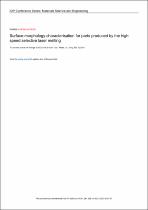 ResearchSpace
ResearchSpace
Surface morphology characterisation for parts produced by the high speed selective laser melting
JavaScript is disabled for your browser. Some features of this site may not work without it.
- ResearchSpace
- →
- Research Publications/Outputs
- →
- Conference Publications
- →
- View Item
| dc.contributor.author |
Shange, Mfanufikile

|
|
| dc.contributor.author |
Yadroitsava, I

|
|
| dc.contributor.author |
Pityana, Sisa L

|
|
| dc.contributor.author |
Yadroitsev, I

|
|
| dc.contributor.author |
Bester, Duwan C

|
|
| dc.date.accessioned | 2019-12-12T09:24:32Z | |
| dc.date.available | 2019-12-12T09:24:32Z | |
| dc.date.issued | 2019-11 | |
| dc.identifier.citation | Shange, M. et al. 2019. Surface morphology characterisation for parts produced by the high speed selective laser melting. In: Conference of the South African Advanced Materials Initiative (CoSAAMI 2019), Vanderbijlpark, South Africa, 23-26 October 2019 | en_US |
| dc.identifier.issn | 1757-899X | |
| dc.identifier.issn | 1757-8981 | |
| dc.identifier.uri | https://iopscience.iop.org/article/10.1088/1757-899X/655/1/012045 | |
| dc.identifier.uri | https://iopscience.iop.org/article/10.1088/1757-899X/655/1/012045/pdf | |
| dc.identifier.uri | doi:10.1088/1757-899X/655/1/012045 | |
| dc.identifier.uri | http://hdl.handle.net/10204/11262 | |
| dc.description | Copyright 2019 The Authors. This is an open access article under the terms of the Creative Commons Attribution License, which permits use, distribution and reproduction in any medium, provided the original work is properly cited. | en_US |
| dc.description.abstract | Additive Manufacturing (AM) systems are unique in terms of fast production and lead time to market. South Africa has built the AM Laser Powder Bed Fusion (LPBF) machine called Aeroswift with the world's largest build volume and highest speed. Surface roughness of LPBF parts depends on process-parameters. High surface roughness and deformations during processing limit the application of this technology for certain industrial applications that require high precision. This study characterises the surface roughness for self-supported parallelepipeds samples produced using the Aeroswift platform. Test artefact parallelepipeds were built with 0-90 degrees sloping angles with respect to the building direction. Surface roughness for the as-built samples was analysed using Mitutoyo SURFTEST SJ-210 system and Zeiss Smartzoom 5 digital microscope. It was found that roughness values were higher for the bottom surfaces (overhang part) compared to upward surfaces, as expected. This was attributed to the higher amount of attached partially melted powder particles that were observed on the downward surface. Absolute values of Ra and Rz versus scanning direction and slope angle were found and analysed. | en_US |
| dc.language.iso | en | en_US |
| dc.publisher | IOP Publishing | en_US |
| dc.relation.ispartofseries | Workflow;22946 | |
| dc.subject | Additive Manufacturing | en_US |
| dc.subject | Laser Powder Bed Fusion | en_US |
| dc.subject | LPBF | en_US |
| dc.title | Surface morphology characterisation for parts produced by the high speed selective laser melting | en_US |
| dc.type | Conference Presentation | en_US |
| dc.identifier.apacitation | Shange, M., Yadroitsava, I., Pityana, S. L., Yadroitsev, I., & Bester, D. C. (2019). Surface morphology characterisation for parts produced by the high speed selective laser melting. IOP Publishing. http://hdl.handle.net/10204/11262 | en_ZA |
| dc.identifier.chicagocitation | Shange, Mfanufikile, I Yadroitsava, Sisa L Pityana, I Yadroitsev, and Duwan C Bester. "Surface morphology characterisation for parts produced by the high speed selective laser melting." (2019): http://hdl.handle.net/10204/11262 | en_ZA |
| dc.identifier.vancouvercitation | Shange M, Yadroitsava I, Pityana SL, Yadroitsev I, Bester DC, Surface morphology characterisation for parts produced by the high speed selective laser melting; IOP Publishing; 2019. http://hdl.handle.net/10204/11262 . | en_ZA |
| dc.identifier.ris | TY - Conference Presentation AU - Shange, Mfanufikile AU - Yadroitsava, I AU - Pityana, Sisa L AU - Yadroitsev, I AU - Bester, Duwan C AB - Additive Manufacturing (AM) systems are unique in terms of fast production and lead time to market. South Africa has built the AM Laser Powder Bed Fusion (LPBF) machine called Aeroswift with the world's largest build volume and highest speed. Surface roughness of LPBF parts depends on process-parameters. High surface roughness and deformations during processing limit the application of this technology for certain industrial applications that require high precision. This study characterises the surface roughness for self-supported parallelepipeds samples produced using the Aeroswift platform. Test artefact parallelepipeds were built with 0-90 degrees sloping angles with respect to the building direction. Surface roughness for the as-built samples was analysed using Mitutoyo SURFTEST SJ-210 system and Zeiss Smartzoom 5 digital microscope. It was found that roughness values were higher for the bottom surfaces (overhang part) compared to upward surfaces, as expected. This was attributed to the higher amount of attached partially melted powder particles that were observed on the downward surface. Absolute values of Ra and Rz versus scanning direction and slope angle were found and analysed. DA - 2019-11 DB - ResearchSpace DP - CSIR KW - Additive Manufacturing KW - Laser Powder Bed Fusion KW - LPBF LK - https://researchspace.csir.co.za PY - 2019 SM - 1757-899X SM - 1757-8981 T1 - Surface morphology characterisation for parts produced by the high speed selective laser melting TI - Surface morphology characterisation for parts produced by the high speed selective laser melting UR - http://hdl.handle.net/10204/11262 ER - | en_ZA |





